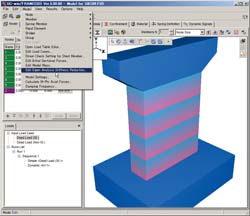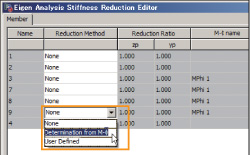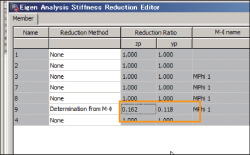The following sentences are stated in the expository writing of "6.2.3
Calculation method of eigen cycle", "March 2002 Highway Bridge
Specification V Seismic Design Volume, dynamic verification with wide application
range, Japan road Association".
| As for the stiffness of bridge pier ------(snip)------, the yield rigidity
of bridge pier is used for the verification of seismic capacity for the
level2 earthquake. |
It is designed to fulfill the seismic capacity of the whole bridge by absorbing the energy due to the plastic member when the strong earthquake such as level 2 occurs. When the plastic performance is applied for the member, the stiffness is reduced and the eigen cycle is becoming long. Though it is necessary to calculate repeatedly to analysis exactly based on the expository writing of the Highway Bridge Specification.
In the previous version of FRAME(3D), the yield rigidity was automatically calculated from the section shape and acting axial force by setting "bilinear" or "linear" as the M-φproperty category, and the eigen cycle was calculated. When "Tri-linear" or "Tetra-linear" is selected in the category and the eigenvalue analysis is performed, the obtained eigen cycle is the value which is calculated with the cracked stiffness.Therefore, when the time history response analysis is performed with "Tri-linear" or "Tetra-linear", it was necessary to prepare the separate model for the eigen cycle calculation.
For this time, the switch is added to use the yield rigidity for eigenvalue analysis in these cases.It is unnecessary to calculate the yield rigidity separately.
- Select "Edit the stiffness reduction value in eigenvalue analysis" from model menu(Figure1).
- Select the element to be reduced and choose the method for it.
It is possible to select from the method where the ratio of cracked stiffness
and yield rigidity from M-φ property is automatically calculated to use
it the reduction ratio or the user defined method(Figure2).
|
 |
|
 |
 |
 |
 Figure1 Selection of model menu Figure1 Selection of model menu |
|
 Figure2 Selection of the element to be reduced and method Figure2 Selection of the element to be reduced and method |
|
